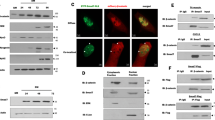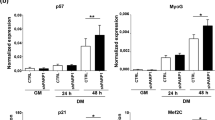Abstract
Mammalian SWI/SNF complexes are ATP-dependent chromatin remodeling enzymes that have been implicated in the regulation of gene expression, cell-cycle control and oncogenesis1,2,3,4. MyoD is a muscle-specific regulator able to induce myogenesis in numerous cell types5. To ascertain the requirement for chromatin remodeling enzymes in cellular differentiation processes, we examined MyoD-mediated induction of muscle differentiation in fibroblasts expressing dominant-negative versions of the human brahma-related gene-1 (BRG1) or human brahma (BRM), the ATPase subunits of two distinct SWI/SNF enzymes. We find that induction of the myogenic phenotype is completely abrogated in the presence of the mutant enzymes. We further demonstrate that failure to induce muscle-specific gene expression correlates with inhibition of chromatin remodeling in the promoter region of an endogenous muscle-specific gene. Our results demonstrate that SWI/SNF enzymes promote MyoD-mediated muscle differentiation and indicate that these enzymes function by altering chromatin structure in promoter regions of endogenous, differentiation-specific loci.
This is a preview of subscription content, access via your institution
Access options
Subscribe to this journal
Receive 12 print issues and online access
$209.00 per year
only $17.42 per issue
Buy this article
- Purchase on Springer Link
- Instant access to full article PDF
Prices may be subject to local taxes which are calculated during checkout



Similar content being viewed by others
References
Vignali, M., Hassan, A.H., Neely, K.E. & Workman, J.L. ATP-dependent chromatin-remodeling complexes. Mol. Cell. Biol. 20, 1899–1910 (2000).
Muchardt, C. & Yaniv, M. The mammalian SWI/SNF complex and the control of cell growth. Semin. Cell Dev. Biol. 10, 189–195 (1999).
Kingston, R. & Narlikar, G. ATP dependent remodeling and acetylation as regulators of chromatin fluidity. Genes Dev. 13, 2339–2352 (1999).
Imbalzano, A. ATP dependent chromatin remodelers: complex complexes and their components. Crit. Rev. Euk. Gene Exp. 8, 225–255 (1998).
Davis, R., Weintraub, H. & Lassar, A. Expression of a single transfected cDNA converts fibroblasts to myoblasts. Cell 51, 987–1000 (1987).
Kowenz-Leutz, E. & Leutz, A. A C/EBPβ isoform recruits the SWI/SNF complex to activate myeloid genes. Mol. Cell 4, 735–743 (1999).
Novitch, B.G., Mulligan, G.J., Jacks, T. & Lassar, A.B. Skeletal muscle cells lacking the retinoblastoma protein display defects in muscle gene expression and accumulate in S and G2 phases of the cell cycle. J. Cell Biol. 135, 441–456 (1996).
de la Serna, I.L. et al. Mammalian SWI-SNF complexes contribute to activation of the hsp70 gene. Mol. Cell. Biol. 20, 2839–2851 (2000).
Kalpana, G.V., Marmon, S., Wang, W., Crabtree, G.R. & Goff, S.P. Binding and stimulation of HIV-1 integrase by a human homolog of yeast transcription factor SNF5. Science 266, 2002–2006 (1994).
Thayer, M.J. et al. Positive autoregulation of the myogenic determination gene MyoD1. Cell 58, 241–248 (1989).
Dunaief, J.L. et al. The retinoblastoma protein and BRG1 form a complex and cooperate to induce cell cycle arrest. Cell 79, 119–130 (1994).
Reyes, J.C. et al. Altered control of cellular proliferation in the absence of mammalian brahma (SNF2α). EMBO J. 17, 6979–6991 (1998).
Shanahan, F., Seghezzi, W., Parry, D., Mahony, D. & Lees, E. Cyclin E associates with BAF155 and BRG1, components of the mammalian SWI-SNF complex, and alters the ability of BRG1 to induce growth arrest. Mol. Cell. Biol. 19, 1460–1469 (1999).
Zhang, H.S. et al. Exit from G1 and S phase of the cell cycle is regulated by repressor complexes containing HDAC–Rb–hSWI/SNF and Rb–hSWI/SNF. Cell 101, 79–89 (2000).
Strobeck, M.W. et al. BRG-1 is required for Rb mediated cell cycle arrest. Proc. Natl. Acad. Sci. USA 97, 7748–7753 (2000).
Kwon, H., Imbalzano, A.N., Khavari, P.A., Kingston, R.E. & Green, M.R. Nucleosome disruption and enhancement of activator binding by a human SWI/SNF complex. Nature 370, 477–481 (1994).
Imbalzano, A.N., Kwon, H., Green, M.R. & Kingston, R.E. Facilitated binding of TATA-binding protein to nucleosomal DNA. Nature 370, 481–485 (1994).
Wang, W. et al. Purification and biochemical heterogeneity of the mammalian SWI-SNF complex. EMBO J. 15, 5370–5382 (1996).
Gerber, A.N., Klesert, T.R., Bergstrom, D.A. & Tapscott, S.J. Two domains of MyoD mediate transcriptional activation of genes in repressive chromatin: a mechanism for lineage determination in myogenesis. Genes Dev. 11, 436–450 (1997).
Cheng, T.C., Wallace, M.C., Merlie, J.P. & Olson, E.N. Separable regulatory elements governing myogenin transcription in mouse embryogenesis. Science 261, 215–218 (1993).
Yee, S.P. & Rigby, P.W. The regulation of myogenin gene expression during the embryonic development of the mouse. Genes Dev. 7, 1277–1289 (1993).
Fryer, C.J. & Archer, T.K. Chromatin remodelling by the glucocorticoid receptor requires the BRG1 complex. Nature 393, 88–91 (1998).
Lu, J., McKinsey, T.A., Zhang, C.L. & Olson, E.N. Regulation of skeletal myogenesis by association of the MEF2 transcription factor with class II histone deacetylases. Mol. Cell 6, 233–244 (2000).
Sartorelli, V. et al. Acetylation of MyoD directed by PCAF is necessary for the execution of the muscle program. Mol. Cell 4, 725–734 (1999).
Weintraub, H., Davis, R., Lockshon, D. & Lassar, A. MyoD binds cooperatively to two sites in a target enhancer sequence: occupancy of two sites is required for activation. Proc. Natl. Acad. Sci. USA 87, 5623–5627 (1990).
Kowalik, T.F., DeGregori, J., Schwarz, J.K. & Nevins, J.R. E2F1 overexpression in quiescent fibroblasts leads to induction of cellular DNA synthesis and apoptosis. J. Virol. 69, 2491–2500 (1995).
Lassar, A. et al. Functional activity of myogenic HLH proteins requires hetero-oligomerization with E12/E47-like proteins in vivo. Cell 66, 305–315 (1991).
Javed, A. et al. Multiple Cbfa/AML sites in the rat osteocalcin promoter are required for basal and vitamin D-responsive transcription and contribute to chromatin organization. Mol. Cell. Biol. 19, 7491–7500 (1999).
Brown, S.A. & Kingston, R.E. Disruption of downstream chromatin directed by a transcriptional activator. Genes Dev. 11, 3116–3121 (1997).
Edmondson, D.G., Cheng, T.C., Cserjesi, P., Chakraborty, T. & Olson, E.N. Analysis of the myogenin promoter reveals an indirect pathway for positive autoregulation mediated by the muscle-specific enhancer factor MEF-2. Mol. Cell. Biol. 12, 3665–3677 (1992).
Acknowledgements
We thank A. Lassar, B. Novitch and A. Javed for reagents and advice; R. Kingston for suggesting this line of experimentation; D. Edmondson and E. Olson for the myogenin genomic clone; S. Sif, L. Shopland, D. Hill, C. Guidi and C. Peterson for comments on the manuscript; and D. Hill and C. Baron for help with the figures. This work was supported by grants from the NIH to I.L.d.l.S. and A.N.I. and by a Scholar Award from the Leukemia and Lymphoma Society to A.N.I.
Author information
Authors and Affiliations
Corresponding author
Rights and permissions
About this article
Cite this article
de la Serna, I., Carlson, K. & Imbalzano, A. Mammalian SWI/SNF complexes promote MyoD-mediated muscle differentiation. Nat Genet 27, 187–190 (2001). https://doi.org/10.1038/84826
Received:
Accepted:
Issue Date:
DOI: https://doi.org/10.1038/84826
This article is cited by
-
Impact of ARID1A and TP53 mutations in pediatric refractory or relapsed mature B-Cell lymphoma treated with CAR-T cell therapy
Cancer Cell International (2023)
-
Structural disruption of BAF chromatin remodeller impairs neuroblastoma metastasis by reverting an invasiveness epigenomic program
Molecular Cancer (2022)
-
Transcriptional networks controlling stromal cell differentiation
Nature Reviews Molecular Cell Biology (2021)
-
Differential roles of ARID1B in excitatory and inhibitory neural progenitors in the developing cortex
Scientific Reports (2021)
-
SMARCA4 deficient tumours are vulnerable to KDM6A/UTX and KDM6B/JMJD3 blockade
Nature Communications (2021)



